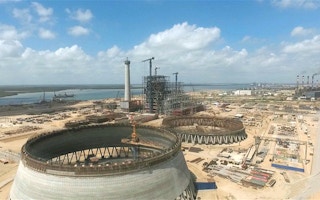Pakistan received positive attention when Prime Minister Imran Khan announced that his nation “will not have any more power based on coal” at the December 2020 Climate Ambition Summit.
To continue reading, subscribe to Eco‑Business.
There's something for everyone. We offer a range of subscription plans.
- Access our stories and receive our Insights Weekly newsletter with the free EB Member plan.
- Unlock unlimited access to our content and archive with EB Circle.
- Publish your content with EB Premium.
At the time, the Institute for Energy Economics and Financial Analysis (IEEFA) recognised the announcement as a significant moment, noting that it was not clear exactly what this meant for already proposed coal power projects.
This announcement was followed by another major one from China – President Xi’s statement at the United Nations in September 2021 that China would not build any more coal plants overseas.
Together, these announcements looked to have significant implications for future power development within the China-Pakistan Economic Corridor (CPEC) – a scheme that is a key part of China’s Belt and Road Initiative (BRI) and has already developed several Chinese-built and financed coal power plants in Pakistan.
However, following Prime Minister Khan’s recent trip to China, it has been reported that the Gwadar coal-fired power project, which was thought to be a prime candidate for cancellation following the two announcements, is to continue with higher priority.
“
Pakistan is clearly not responsible for global climate change. However, it would seem that its pledge on coal power doesn’t count for much.
This project has not reached construction nor even financial close. The 300 megawatt (MW) Gwadar Coal Power Plant is a CPEC project 75 per cent controlled by China Communications Construction Group with the Industrial and Commercial Bank of China (ICBC) as a potential financier.
Pakistan is clearly not responsible for global climate change. However, it would seem that its pledge on coal power doesn’t count for much.
Further, the Gwadar plant is to be fuelled by imported coal. In its 2021 updated Nationally Determined Contributions (NDC) document, Pakistan stated: “From 2020 onwards, a moratorium is in place on new imported coal-based power plants.”
The continuation of the Gwadar project goes against Pakistan’s stated aim to shift away from fuel imports and towards reliance on domestic resources, as set out in the 2021 National Electricity Policy
There are indications that a planned unit at the non-CPEC Jamshoro coal power project has been cancelled but it seems that CPEC coal projects are an exception to the pledges made by Pakistan and China.
As a result, it seems possible that another CPEC coal project that has yet to begin construction – the 1,320 megawatt Thar Oracle power plant and mine – could also go ahead.
Outside of Pakistan, there are indications that China is stepping away from coal projects that were already in the planning stage. A 700MW coal-fired power plant in Bosnia and Herzegovina– which was to be constructed by China National Electric Engineering Company – now looks in doubt after Chinese banks refused to fund the project.
A new report on the BRI from Fudan University found that no coal projects received finance or investment from China in 2021. It seems that may change in 2022 if the Gwadar coal project reaches financial close.
CPEC coal plants are a burden for Pakistan, not a development boost.
On his recent visit to China, Prime Minister Imran Khan reportedly aimed to draw attention to “the exceptional rise in capacity payments because of near simultaneous arrival of new capacity from projects undertaken under CPEC”.
Capacity payments – which have to be made to power plants whether they are generating power or not – have been growing alarmingly in recent years and are set to continue rising fast amid worsening overcapacity as under-construction power plants are completed.
The payments are on course to approach $10 billion by 2023 with Chinese companies receiving about half of that for CPEC power projects. About $1.1 billion of capacity payments reportedly remain outstanding to CPEC power projects.
These payments raise the per unit cost of power, in turn worsening the huge and unsustainable debt build-up within the power system, which is $14 billion and rising.
The IMF has consequently insisted on large consumer power tariff increases to try and address the problem, as part of its $6 billion bail-out package for Pakistan.
CPEC coal power projects have clearly been an economic disaster for Pakistan. This is perhaps not surprising given how Chinese developers were able to lock in deal terms in their favour.
In addition to insisting on capacity payments, which effectively pass the risk of lower-than-expected power plant utilisation on to the government and consumers in Pakistan, Chinese companies have been allowed to achieve a high return on equity.
Chinese developers can also claim their political risk insurance costs and have short, 10-year debt repayment periods. This last term is making capacity payments particularly burdensome as such payments are designed to cover the coal plants’ fixed costs including interest and debt payments.
It is therefore unsurprising that Pakistan has already asked for debt relief on CPEC power projects, apparently to no avail.
A number of under-construction CPEC and non-CPEC coal power plants will shortly come online in Pakistan, further worsening overcapacity. These projects were never going to be impacted by the “no more coal” pledges by Pakistan and China.
However, as the Gwadar project has not reached financial close, it makes little sense for Pakistan and China to undermine their much-heralded coal pledges – given the financial and economic burden of CPEC coal projects to date and Pakistan’s obvious overcapacity problem.
The fact that the plant will operate on imported coal will further expose Pakistan to fossil fuel price volatility risks following recent price spikes for coal and LNG.
Chinese companies will likely be protected and do well out of the Gwadar power project. Pakistan would be better off if it stuck to the letter of its coal pledge.











